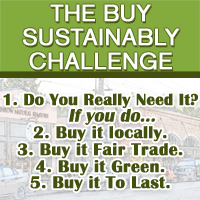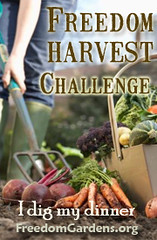The hubby and I are back from our long weekend in D.C., celebrating his 30th birthday! I can’t believe we’re 30…we celebrated each other’s 16th birthdays together!
We had a great time, and even though we didn’t intend for our vacation to be a “green” vacation, we did our best to make good choices.
 We flew on Southwest out of Albany and straight into BWI. While not very close to D.C., it was a great price, and we used public transportation to get into D.C. The ride was really quick – about 50 minutes in the air. If we had driven, it would have taken 6 and a half hours, if we had taken the train, closer to 9 or 10. (Which is really ridiculous, when you think about it, because it’s a fairly straight shot).
We flew on Southwest out of Albany and straight into BWI. While not very close to D.C., it was a great price, and we used public transportation to get into D.C. The ride was really quick – about 50 minutes in the air. If we had driven, it would have taken 6 and a half hours, if we had taken the train, closer to 9 or 10. (Which is really ridiculous, when you think about it, because it’s a fairly straight shot).
So we debated which was our smallest carbon footprint, and decided, in order, train was the smallest footprint, followed by plane, followed by car. Our flight was packed, and when you think about each of those people/families, taking a car 6.5 hours to D.C., the emissions are pretty tremendous.
 We arrived in D.C., headed over to the Amtrak/M.A.R.C. station and took a train into Union Station, then the Metro to Dupont Circle, and checked in at our hotel, Hotel Palomar. It was a pretty nice hotel, but I don’t know if we’d stay there again. We were very pleased with its Eco-Pledge though. They print everything on recycled paper with soy-based inks, have recycle cans in each hotel room, and even participated in Earth Hour.
We arrived in D.C., headed over to the Amtrak/M.A.R.C. station and took a train into Union Station, then the Metro to Dupont Circle, and checked in at our hotel, Hotel Palomar. It was a pretty nice hotel, but I don’t know if we’d stay there again. We were very pleased with its Eco-Pledge though. They print everything on recycled paper with soy-based inks, have recycle cans in each hotel room, and even participated in Earth Hour.
Earth Hour was Saturday night and I was really please to get notice, upon returning to our room, that they were participating. From 8:30-9:30pm on March 28, 2009, the organizers of Earth Hour were trying to get 1 billion people to participate globally in turning off their lights. While obviously we were in a hotel, and for liability purposes they couldn’t turn everything off, they dimmed all of their lights, asked their guests to keep their tvs and room lights off, and turned off all their exterior and non-essential lighting for the hour. Very cool.

In front of the Capitol
The next day, K and I headed back to Union Station to start our trolley tour. We spent the day seeing the sights with Old Town Trolley Tours, enjoying the conductor’s stories about different locales. One of our favorite things about the tour was that the trolleys they use run totally on propane. We saw the Capitol, Supreme Court, Library of Congress and spent the rest of the afternoon in the Smithsonian Air and Space Museum before heading out to a delicious dinner at D.C. Coast. We were trying to fit in as much seafood as we could while we were in the area!
Late Sunday morning, I headed over with my friend Toby to meet up with some friends for brunch at Firefly. This place was fantastic! Their menu is designed to utilize products from local farms and farmers.
A few of them:

With friends in front of Firefly
- endless summer harvest
- new morning farm
- baxters crabs
- prime seafood (wild alaskan fish)
- dolcezza gelateria
- pipe dreams dairy
- eco farm (greens & pottery)
- cowgirl creamery
- eberly organic chicken
- elysian fields lamb
- eco friendly foods (pastured pork)
- kreider dairy (BGH free milk)
- la pasta
- tuscarora organic growers coop
- northern neck farm
Toby and I split some challah french toast and a mushroom and cheese omelet. Delish!

Dupont Circle Farmers Market
All too soon I returned to K, who was wandering through the Dupont Circle Farmer’s market. The market was actually smaller than our Troy or even Schenectady farmer markets but they had a lot more things for sale – including seafood! Given where we live, we will likely never see seafood as we are nowhere near the ocean 🙂 It was pretty cool and K felt proud of himself in passing by 2 Starbucks while purchasing his coffee at the market.
We spent another day on the trolley tour, seeing the memorials, walking through the tidal basin and seeing the cherry blossoms in bloom! The Cherry Blossom Festival actually started that day, and the weather got to 74F, beautifully sunny, and the trees and sky were just beautiful. We debated going paddleboating, but totally forgot as we continued walking around.

Jefferson Memorial and the Tidal Basin
Finally, that evening, we ended up at Hank’s Oyster Bar. We enjoyed ordered some oysters and clams on the half shell to start. We started off with some Sting Ray oysters, local to the Chesapeake area, and they were mild-flavored and slightly salty. Yum…then we went on to try some Top Neck clams. These are slightly bigger than the Little Neck clams we are used to and are also local, from the eastern shore of the Chesapeake bay. All in all, absolutely delightful!
It was sad to come back from our little sojourn, but it was made slightly better by a voice mail left for us letting us know that we are getting a community garden plot starting next week! I’ve already started researching heirloom varieties and hardiness zones and I can’t wait!
Filed under: Green Living | Tagged: carbon footprint, cherry blossom, d.c. coast, Earth Hour, farmers market, firefly, hank's oyster bar, trolley tour, washington d.c. | 1 Comment »


























 Quintessential Dutch home dated 1742.
Quintessential Dutch home dated 1742.















